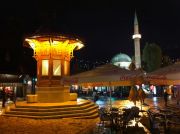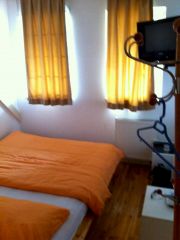Following the damage in the 1990s and then wild and chaotic reconstruction in 2000s, Sarajevo's attractiveness declined dramatically. Sadly! The old town is now a combination of lovely old shops and newly built houses. Traffic in the city makes it worse.
|
 |
 |
 |
 |
 |
 |
 |
 |
Sarajevo at night, the public water fountain.
 |
 |
The capital of Bosnia and Herzegovina did not appear very pretty at all, on the first sight. Chaotic, overbuilt with concrete blocks of flats, and paralysed by traffic. These were my first impressions. I did appreciate its great location amongst green hills, though. The city was spread roughly from east to west, like a piece of kebab, with the old town placed on the easterly end.
It has been a longer while since my last great disappointment with a place, which I wanted to see that much. Perhaps my expectations were too high or many descriptions and reports from the city were over inflated and exaggerated. I do not want to overstate my impressions about Sarajevo here, either. When I arrived in Sarajevo it was raining badly. Exploring, wandering, simply visiting was therefore impaired and may have influenced my perception. What I expected was a highly diverse city with a lovely old district - a meeting place of two most significant cultures in this part of the world, the Christian and the Muslim. There was some of that, but one had to squint their eyes.
I wandered in the rain about the old district, part of which was truly picturesque and atmospheric. And when the night fell, the illuminated old structures reflected their facades and silhouettes in the wet pavements. Then, I started to relax and began soaking and appreciating the ambiance of Sarajevo. It even stopped raining for a while (but by that time, I had already acquired an umbrella), so I took out my camera to take some photos. I started wondering how the city might have looked like before the Balkan wars, at the time when Winter Olympic Games took place there.
|
|
| Favourite spots: |
 |
 |
 |
 |
 |
 |
 |
 |
Souvenir shops at the old town.
 |
 |
Oh, dear. Sarajevo does not have many attractive spots anymore, so choosing a favourite place would typically be narrowed down to a very small area considered the old town. This is where the nice Ottoman-inspired little architecture remains, which manages to give the city somewhat pleasant atmosphere. I liked the white washed one story buildings lining a couple of narrow alleys between two of the larger mosques. Most of the buildings house shops, pattiseries, eateries, cafes, restaurants, and ... a tourist information office. Fortunately, when I visited, many of the shops sold household goods typical for Middle East - brass and silver utensils, little pots, pans, and water pipes, as well as tiny glass tea pots. They almost shined. It was nice to wander around examine the goods or sit down at one of the eateries and watch people browse the venues.
|
|
| What's really great: |
 |
 |
 |
 |
 |
 |
 |
 |
Gazi Husrev-begov medresah
 |
 |
I think it was nice to see that live continued in Sarajevo despite the horrific recent history. The scars of war were too visible almost everywhere, but it did look like people tried to move on. Although not very attractive, the new buildings replaced the ruins in somewhat uncoordinated way. On the other hand, normality was on its way in. That was clear. The shops were full of goods, which could be easily spotted in any larger European city.
Also, it was good to see that some places, most of which made up the quality of the mutlicultural fabric of Sarajevo, survived. I mean those that were associated places of worship of teological education, like medresas, mosques, churches. And the fact that it was possible to visit them was refreshing. Very refreshing indeed.
|
|
| Sights: |
 |
 |
 |
 |
 |
 |
 |
 |
The courtyard of Gazi Husrev-beg Mosque.
 |
 |
In the old town, the sights of Sarajevo included the following.
The Gazi Husrev-Beg Mosque - free entry - a large and prominent object, right in the middle of the old town. It had an interesting courtyard and fountain sheltered with a wooden 'parasol' standing on thin wooden pillars.
The Sebilj - public drinking fountain - standing in the middle of the square, which was almost symbolically was the entry to the old Sarajevo. It was still working when I visited and it looked at its best during the night, when it was illumiated by golden lights.
The Sahat-kula - clock tower - dating back to the 17th century, it is considered by many as one of the most beautiful, striking and tallest clock towers in Europe.
The Caravanserai of Morića-Han - shelter for caravans, last remaining in Sarajevo - is a large, monumental building lining one of the old town's narrow but main alleys.
The Gazi Husrev-begov medresah - a small stone building, very typical Islamic structure for a teological school.
|
|
| Accommodations: |
 |
 |
 |
 |
 |
 |
 |
 |
The tiny room no.207 at the Hayat Hotel.
 |
 |
After a quick research on the net about hostels and hotels in Sarajevo, it turned out that booking.com had decent offers on some of the central accommodation options with 25% off on average. So I decided to book a hotel in advance. I would have enough time to find something upon arrival, but I did not want to waste my time. It was raining when I arrived, so it turned out to be a good decision. Hotel Hayat (sic!) was about a minute away from the Sebilj. It was modern and receptionists spoke some English. My room (#207) was tiny. A double bed barely fit there and there was not much room to stand there. The bathroom was minute as well, and I swear that had I eaten too much ćevapi, I would have not been able to squeeze through the door. It only partially opened, as the shower cabin blocked it. When I wanted to use a toilet, I had to step inside the shower and close the door. Well, but for €28 it was not so bad (official price €35), and the location was perfect! The hotel had free wifi.
|
|
| Nightlife: |
 |
 |
 |
 |
 |
 |
 |
 |
Shopping avenue leading to the Martića Square.
 |
 |
The more trendy cafes and bars, with their tables and armchairs under canopy parasols were based along Štrosmajerova Street, just off the Martića Square, where the Catholic Cathedral stood. They looked like they could be based in any large city in the world, where cafe culture is a must for the 'civilised development' of the society. It was no different in Sarajevo. The large number of the cafes and clubs, many grouped together, just one next to another, indicated that nightlife was important for Bosniaks, too. Their decor was pleasant and varied from plush to contemporary to very trendy and funky.
|
|
| Hangouts: |
 |
 |
 |
 |
 |
 |
 |
 |
The Divan Cafe, and their pear cake
 |
 |
The Sur Caffe Bar Oaza on one of the pedestrianised alleys of the old town, served good value espresso and Bosnian coffee for BAM1.50 (£0.68; €0.77; $1.12) and a selection of cakes. I hid myself from rain at the less funky Alfonso for a glass of draft Sarajevsko lager and free wifi. It was an excellent spot to watch people as well.
And yet, probably one of the most colourful and pleasant spot to drink teas, eat traditional cakes (baked inside a pear) and relax was the Divan Cafe, set below the Gazi Husrev-Begov house. That looked rich and very flamboyant. Adjacent to the cafe, set in the house's courtyard was a Persian shop selling rugs, carpets, scarves, throws, hats, robes - all very colourful. The cafe shared its kitchen with the Morića Han Restaurant specialising in national cuisine. This could be one of the most pleasant and easy-on-the-eye cafe and restaurant in the entire city.
|
|
| Restaurants: |
 |
 |
 |
 |
 |
 |
 |
 |
Šeher Restaurant's ćevapi at the old town.
 |
 |
When it was time for late lunch at the old town, ćevabdžinicas and buregdžinicas started appearing around each corner. Some were very busy, some not so busy, and a few not busy at all. I wanted to sit outside, so I was picky. Those busy ones had all tables in the pavement occupied. I browsed a little and went for the Šeher restaurant and ordered my large portion of ćevapi for BAM5.
The temperature dropped considerably after sunset, so for dinner I thought I ought to eat inside. After browsing for about an hour, decision was made to try the Planet pizza restaurant in he heart of the old town. Their pizzas were ranging reasonably BAM6-BAM7, but smallest possible bottles of Coke were half that, which was a total rip-off. They were even more expensive than their excellent selection of cakes!
|
|
| Other recommendations: |
 |
 |
 |
 |
 |
 |
 |
 |
View of Sarajevo from one of the bridges near the old part of the city.
 |
 |
I came to Sarajevo by coach from Jajce, which was a very intersting ride - long and crowded. The road network in Bosnia and Hercegovina was not great, the quality of the vehicles and the driving did not impress at all. Still, the city was connected by public buses (or coaches - if the quality of the vehicles secures the use of this word) rather well. All major town had a regular, at least one a day, connection with the capital.
I also used the train. The ride from Sarajevo to Mostar was supposed to be amongst the most pleasant and scenic, offering views of the dramatic landscape. Well, it almost did. Yet, I had this bad luck, that the line was undergoing a major re-built and for a very large part of the journey, there was a replacement bus service in place. It still went over the dramatic landscape, but it took very long and it was not very comfortable. Hopefully, when the line is repaired, the train trip on this route will be fun again.
|
|
Published on Wednesday June 8th, 2011
|
|
 Publish on Facebook
Publish on Facebook
|
Wed, Jun 22 2011 - 01:30 AM
 by ravinderkumarsi
| very nice and well written |
Wed, Jun 08 2011 - 10:45 AM
 by recaro94 by recaro94
| Sad :( sounds beat up. Hopefully the train is fixed soon, I plan to be here in 3 months! |
| Information: |
| Login if you are a member, or sign up for a free membership to rate this report and to earn globo points! |
|
| Belgium |
|
|
|
|
|
|
 |
| Benin |
|
|
 |
| Bosnia - Herzegovina |
|
|
|
|
|
|
|
|
 |
| Botswana |
|
|
 |
| Brazil |
|
|
|
|
|
|
|
|
|
|
|
|
|

|
